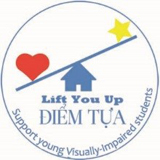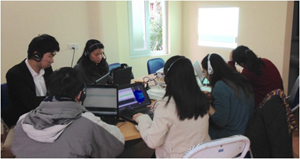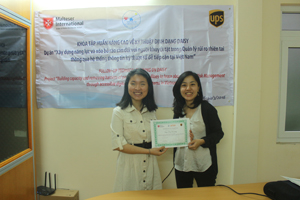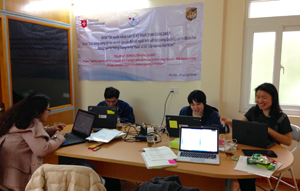- HOME
- Alumni News
- Activity Reports
- Huong's Activity Reports
Activity Reports
Huong's Activity Reports

FINAL NARATIVE REPORT
Project title: “Building capacities and removing barriers for people with disabilities in disaster risk reduction through the digital accessible information system in Vietnam”
I. GENERAL INFORMATION
Project title: “Building capacities and removing barriers for people with disabilities (PWDs) in disaster risk reduction (DRR) through the digital accessible information system (DAISY) in Vietnam”
Project period: 01 October 2015-31 May 2016
Donor: UPS through Malteser International
Organization: Lift You Up Group, Hanoi Rehabilitation and Vocational Training Center for Young Persons with Visual Impairments
Address: 21B Lac Trung Street, Hai Ba Trung District, Hanoi, Vietnam
Contact person: Thu Huong Dao, Lift You Up Founder/ Leader
E-mail: tt.diem.tua@gmail.com
Fanpage: https://www.facebook.com/LiftYouUpCenter
Phone: +84 988 675 985
II. PROJECT BACKGROUND
1. PEOPLE WITH DISABILITIES AND WITH PRINT DISABILITIES IN VIETNAM
According to the 2009 Census, more than 6 million Vietnamese people aged 5 and older, accounting for 7.8% of the population, are classified as PWDs. However, this community’s population doubles to 15.3% in a recent statistics based on the World Health Organization framework. 75% of Vietnamese PWDs live in rural areas. Their literacy rate is far lower than that of persons without disabilities (76.3% as opposed to 95.2% respectively).
‘Print disabilities’ is a recent terminology, defined as the types of visual, cognitive, or physical disabilities which hinder people from accessing printed text on the paper. They may include persons with visual impairments, psychiatric disabilities, attention deficit/hyperactivity disorder, autism, dyslexia, physical disabilities (who cannot hold a book and turn the pages), hearing impairment, intellectual disabilities, psychiatric disabilities (e.g. concentration disorders); illiterate people; people with temporary print disabilities (including travellers); or the elderlies (who cannot read with small font size). There is currently no official statistics on these types of disabilities in Vietnam. However, they should make up a large proportion in the population with disabilities according to this definition.
2. PEOPLE WITH DISABILITIES AND THE DISASTER RISK MANAGEMENT IN VIETNAM
There has been so far no data on the number of PWDs affected by natural disasters or their contributions to the CBDRM in Vietnam. The first endeavor to include PWDs in the mainstream disaster risk management (DRM) here was possibly done by Malteser International (MI) with its disability-inclusive disaster risk reduction (DIDRR) project piloted in Quang Nam Province, a locality frequently hit by typhoons, in April 2012. Cooperating with Quang Nam association of PWDs, the project has been training PWDs and their families in 46 villages to actively contribute to their local DRR processes. It also establishes, trains, and equips a local rescue team to assist the PWDs and their families, abiding the priority evacuation list. Rather than an afterthought of a general plan, participants with disabilities in the project are empowered to raise their voices and actively contribute to their own community’s DRM for better preparedness and safety. A DIDRR manual has been compiled in the project to provide step-by-step guide for DIDRR in Vietnam.
In their DIDRR agenda, a survey was conducted by MI, Swiss Red Cross, and their DPOs partners in Quang Nam. The preliminary results of the survey demonstrate the PWDs’ concern about their lack of information and support to protect themselves from disasters. Among 733 participants with disabilities from disaster-prone areas in the survey, more than 50% do not know how to plan for their evacuation or self-protection; 73% are not aware of or not sure of their community’s emergency plans; and around 70% say they are not involved in making decisions on DRM although 54% wish so. The investigation also discovers that there is no priority of early warning assistance for PWDs; they and their family members are not members of the village DRM committees. This survey in Vietnam was part of global efforts launched by the United Nations Office for DRR with data collected from 120 nations worldwide till the end of 2013. This was the first global scale survey to investigate how PWDs handle disastrous situations. Its findings imply that despite their extreme vulnerability in those circumstances, PWDs have little access to the decision-making process which determines their own safety.
3. SITUATIONS OF DAISY IN VIETNAM
DAISY first came to Vietnam in 2005 with a workshop organized by Mr. Hiroshi Kawamura, the president of DAISY Consortium and Mr. Monthian Buntan, the committee member of the rights of PWDs. A DAISY production training followed in March 2006 for 10 trainees, including two with visual impairments. Although the participants acquired basic skills of DAISY production after the training, DAISY production activities have hardly been implemented in Vietnam ever since due to lack of awareness of its usefulness and lack of proper attention and resources.
After around ten years, there currently exist favourable conditions for DAISY development in Vietnam. The Vietnamese IT market is booming with 35 million mobile users (out of which 18 million are using smartphones) and 16.1 million monthly PC users, the most active online population in Southeast Asia. The country is the 17th highest number of Internet users, the 5th highest Internet penetration (35.6%) in South East Asia, and the 8th highest number of mobile phone subscribers in the world (CIA Factbook 2013). Although there is no separate statistics of PC and mobile users with print disabilities in Vietnam, they are not excluded from these general figures. Their IT literacy is remarkably growing thanks to Vietnamese DPOs’ considerable investment in IT training. Surpassing other developing nations which do not have text to speech (TTS) engines in their local languages, popular screen readers such as Jaws and NVDA are available in Vietnamese. The open source DAISY playback application, AMIS, has also been translated into Vietnamese. In addition, numerous DAISY playback and production software on different platforms (Windows, Android, and iOS) could be downloaded from open sources. There is no need of a special DAISY playback hardware; the readers can read the books on their PCs or affordable mobile devices with operation systems mentioned above.
4. AN OVERVIEW OF LIFT YOU UP GROUP
Lift You Up (LYU) is a community-based group of six young people with and without disabilities under the supervision of Hanoi Rehabilitation and Vocational Training Center for Young Persons with Visual Impairments. The group was founded in September 2012 to support the inclusive education of students with disabilities in Hanoi after the founder, Thu Huong Dao, had completed her Duskin Leadership Training for PWDs in Japan. After various volunteer activities, cooperating with Malteser Vietnam, UPS, and Assistive Technology Development Organization (ATDO), LYU started developing the first project plan on “Building capacities and removing barriers for PWDs in DRR through the digital accessible information system (DAISY) in Vietnam” in May 2014. With this pilot project, LYU will bring DAISY technology back to Vietnam and prove its usefulness and accessibility to the Vietnamese community with print disabilities. Besides, as part of MI’s DIDRR project, as a group of PWDs, LYU will be active participants contributing to the mainstream CBDRM. In a further prospect, the conversion of MI’s DIDRR manual will be the first step for LYU to become a focal point of DAISY production in Vietnam and incorporate the DAISY book production in their inclusive education support.
III. PROJECT SUMMARY
The project is aimed at improving people with print disabilities’ active participation in community-based DRR activities. Through the accessible DIDRR manual in DAISY format, this group will be equipped with fundamental DRR knowledge for their self-protection, mobilization of appropriate support from their families and community members, and their active contributions to DRR activities in their community. To achieve this ultimate goal, the following objectives have been identified:
- Building capacities of full text and full audio DAISY book production for five LYU members with and without disabilities;
- Setting up a focal point of DAISY production in Vietnam at LYU office;
- Converting MI’s English and Vietnamese disability-inclusive community-based disaster risk management (DICBDRM) manual into DAISY format;
- Distributing the DAISY products to about 24,181 PWDs, the project beneficiaries, in seven disaster-prone provinces.
The objectives above are realized by the following activities:
- Establish the first DAISY production focal point in Vietnam by equipping LYU’s office with adequate facilities for its operation;
- Conduct two basic and follow-up DAISY production training for five LYU members;
- Convert MI’s English and Vietnamese DICBDRM manual into DAISY format;
- Conduct a product launching workshop.
IV. PROJECT IMPLEMENTATION PROCESS
From 1 October 2015 to 12 January 2016, all stakeholders had completed administration work and logistics for the project implementation. Facilities, including tables, chairs, lockers, recording booth, laptops, as well as essential DAISY playback and production software had been purchased and installed by MI for LYU’s office.
The official project launching workshop was held on 12 January 2016 and attended by 35 representatives of many organizations of and for PWDs in Hanoi. Addressing at the workshop, Mr. Hiroshi Kawamura from ATDO gave an introductory presentation on DAISY and revealed his optimism about the DAISY development prospects in Vietnam. Subsequently, Ms. Mai Thi Dung, the project manager, showed the audience how DAISY technology fits in the DICBDRM picture. All participants expressed their confidence, appreciation, and support for MI, LYU, and ATDO’s initiatives of DAISY application in the DRR work.
The basic DAISY production training course started in the afternoon of 12 January, after the project launching workshop. Throughout ten days, five LYU members learnt concepts of DAISY, its development history, its advantages compared with printed and audio books, key skills of DAISY playback and full text and full audio DAISY production with both open source and commercial software, including AMIS, Dolphin Easy Reader, Tobi, Obi, and Save as DAISY on Microsoft Word under the guidance of two trainers from ATDO, Ms. Mayu Makio Hamada and Mr. Go Maruichi. The training was well balanced between theories and practice. By the end of the course, all trainees mastered those skills, applied them in the production of the first chapters of the English manual, and reached agreement on a detailed production plan for the English version of the DICBDRM manual, which is a crucial guideline for their coming production stage.
It was a good opportunity for LYU members to put their acquired skills in the real production of the DICBDRM manual as soon as the basic training finished. By 28 March 2016, LYU had basically completed the English manual and the text of the Vietnamese one. There remained some technical issues which arose and could not be resolved in the production period. LYU had to leave them till the follow-up training to discuss with ATDO experts.
In the follow-up training (28 March – 30 March 2016), LYU members had hands-on sessions with Ms. Hamada to troubleshoot remaining technical problems in the first production stage and complete the English version with two TTS voices. Different from the previous training in which participants mainly learned from the trainers, the trainees, in the follow-up training, learned a lot from their own experience and mistakes in their production and worked closely with the trainer to devise solutions for complex objects in DAISY books such as tables with merged and split cells. By the end of the course, participants acquired advanced skills of editing DAISY books and recording audio on Dolphin Publisher and completed the English version with TTS and the text of the Vietnamese version.
In the final stage of the project (from 1 April to 31 May 2016), LYU completed the human voice recording for the Vietnamese version (as Vietnamese TTS with good quality is currently unavailable), addressed remaining technical problems in both versions, and finalized their DAISY products.
During LYU’s DAISY production, monthly group meetings were regularly held for LYU members to discuss their experience, challenges, and solutions. Simultaneously, the group always receives passionate and effective online or on-site support from ATDO. Without their ongoing kind assistance, LYU cannot achieve their production goals with only their first experience in DAISY technology domain.



V. CHALLENGES AND SOLUTIONS
1. TECHNICAL CHALLENGES
- Due to the unexpected incompatibility between the laptops purchased by MI and DAISY applications, it took much time for LYU and ATDO to troubleshoot technical glitches at the beginning of the basic training course. LYU learnt that the pre-installed Windows in the PCs should not be upgraded to higher versions.
- Since none of the DAISY playback and production software is perfect, LYU had diverse difficulties in handling complex tables, table borders, and Vietnamese tree view of the book contents. LYU processed the production and did action research simultaneously to find out solutions for problems incurred, as well as contacted software developers to work out the best solution for each problem. The production period was more time-consuming than expected, but LYU has kept records of their lessons learnt for future projects.
2. ADMINISTRATIVE CHALLENGES
As LYU has not accomplished its legal registration as a local NGO, its paperwork with Hanoi authorities to receive this project from MI was complicated. Fortunately, the group was passionately and effectively supported by Hanoi Rehabilitation and Vocational Training Center for Young Persons with Visual Impairments. LYU will learn the registration procedures. Hopefully, the group can be registered as a local NGO by the end of next year. Besides, as a small organization with the shortage of administration and accounting staff, it was difficult for LYU to satisfy MI’s requirements of bulky administration papers.
VI. PROJECT ACHIEVEMENTS
Overall, the project has achieved its goals and objectives:
- Five LYU members are now capable of reading and producing text and audio DAISY books with complex formats and troubleshooting common problems in the production process. They are ready to receive orders of DAISY production from any client or conduct DAISY training for end users or other producers.
- Basically, LYU office has been equipped to operate as a DAISY production focal point.
- Two English and Vietnamese DICBDRM manuals in DAISY format have been completed and ready for distribution to end users in MI’s project areas.
VII. FUTURE PLANS
This project opens new opportunities for LYU to expand DAISY technology in Vietnam as well as implement better support for inclusive education:
- In the product launching workshop, LYU can build up good ties and network with governmental or non-governmental organizations who are concerned about information accessibility for PWDs to implement together more projects on DAISY use, production, and replication in Vietnam. Moreover, in the workshop, LYU may display several books on essential skills for people with visual impairments or others of their interest to seek funding for the conversion of those books into DAISY format for the readership of this community.
- LYU is planning to write a proposal on more facilities, such as printer, photocopier, scanner, laptop, for LYU office and the translation into Vietnamese and conversion into DAISY format of a book on rehabilitation skills for young adults with vision loss by the American Foundation for the Blind.
- Cooperating with ATDO, LYU is planning to convert academic materials for students with print disabilities into DAISY format, support their use, and establish the first disability support center at a university in Hanoi.
Date: 12 June 2016
Reported by: Thu Huong Dao
Lift You Up Leader




